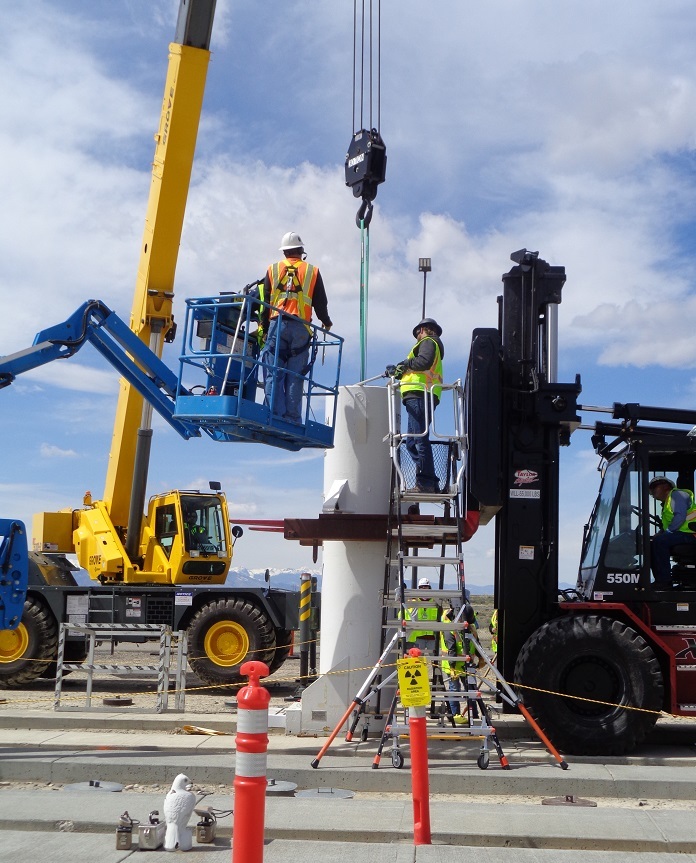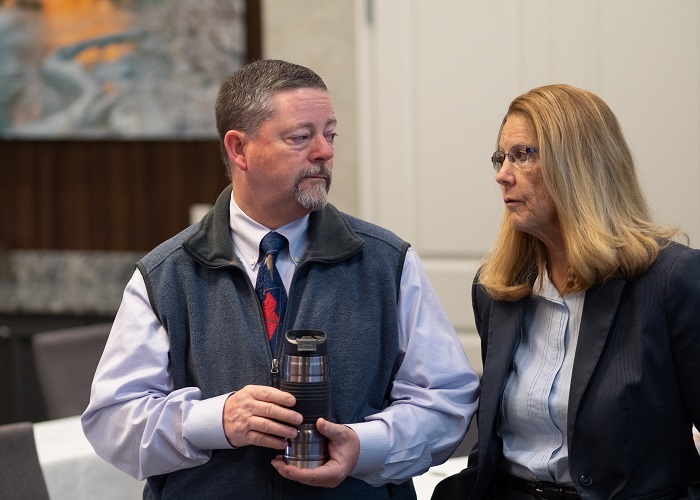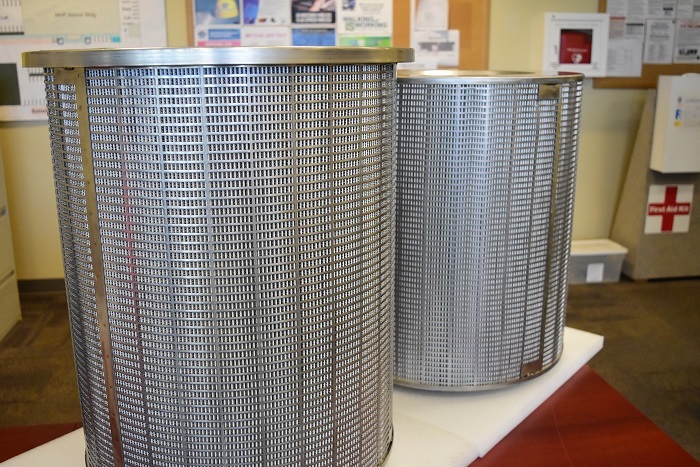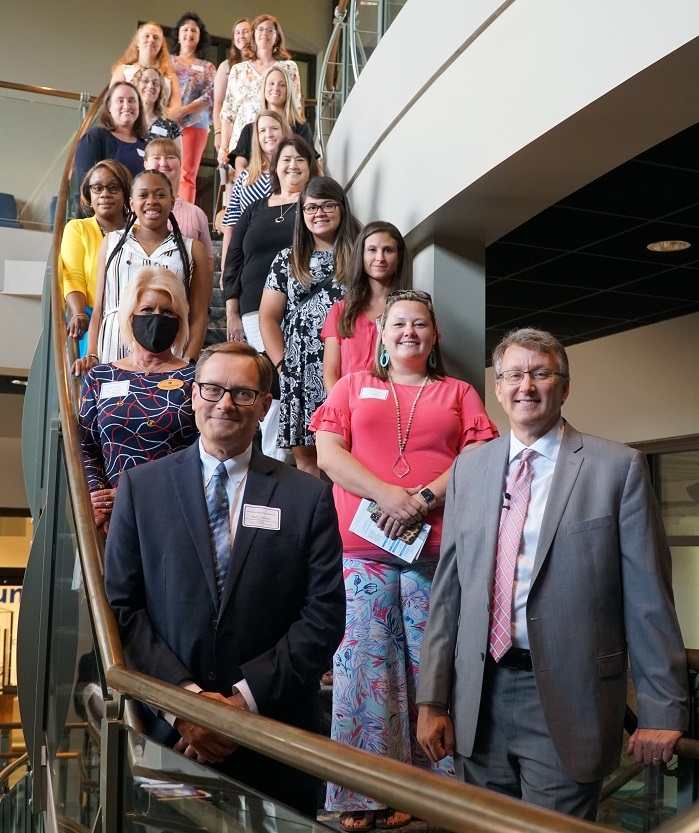|
AIKEN, S.C. – EM has reduced the amount of time to qualify a salt waste batch at the Savannah River Site (SRS), enabling a steady stream of the material to the Salt Waste Processing Facility (SWPF).
This past January, SWPF contractor Parsons Corp. began the first year of operating the facility, which is designed to process up to 9 million gallons of salt waste per year.
Processing 6 million gallons of SRS tank waste in 2021 is an EM priority. To support this priority, SRS liquid waste contractor Savannah River Remediation (SRR) collaborated with the Savannah River National Laboratory to improve processes to expedite the preparation and qualification of salt solution to support processing at these rates. These improvements led to qualifying the latest batch to feed SWPF, known as Salt Batch 3, in a record seven weeks compared to previous batches that took up to six months.
Compiling and qualifying a 1-million-gallon salt batch is a complex process. Improvements made throughout the batch qualification process included streamlining the required salt sample receipt, analysis, data review, and report. This led to expanded use of computer modeling and automated calculations using the sample analysis data, and development and deployment of an electronic approval process. Salt Batch 3 was also the first salt batch to be compiled and qualified in SRR’s newest salt waste blend tank, Tank 41.
SRR President and Project Manager Phil Breidenbach said he is confident in the abilities of SRR and Parsons to advance tank waste processing toward the goal of tank closure at SRS.
“The strong relationships formed over the common goal of eliminating radioactive liquid waste stored in aging waste tanks motivates the team to overcome challenges,” Breidenbach said. “We carefully evaluated the salt batch compilation and qualification procedures and made many changes to streamline the process.”
Once salt waste is received at SWPF, it is treated to remove the high-activity radionuclides. The high-activity stream is transferred to the Defense Waste Processing Facility, where it is converted into a glass form and poured into 10-foot-tall stainless steel canisters, where the glass solidifies. The decontaminated salt solution stream is transferred from SWPF to the Saltstone Production Facility for processing into saltstone and permanent disposal in Saltstone Disposal Units.
SWPF Project Manager Mike Pittman is pleased with the site coordination involved with SWPF, and proud his employees are stepping up to execute the cleanup mission safely.
“Parsons and SRR share a close relationship because we work toward the same goal of eliminating the legacy high-level tank waste to make our environment and community infinitely safer,” Pittman said. “I am proud our team has prevailed through complex construction and startup operations to get to the point of processing radioactive liquid waste.”
DOE-Savannah River Assistant Manager for Waste Disposition Jim Folk said not only does reducing the time to prepare and qualify a salt batch facilitate schedule improvements, but the use of innovative processes and electronic capabilities increases efficiency and safety.
“It takes many people performing many different tasks to prepare and qualify feed for SWPF processing,” Folk said. “At DOE, we are pleased when processes are streamlined by eliminating unnecessary steps, reducing the need for human interaction, and increasing confidence in the safe processing of the salt waste to support DOE’s mission.”
-Contributor: Ashley Dernberger
 A new safety program launched by EM contractor Fluor Idaho benefits all Idaho Cleanup Project employees, including those who transfer spent nuclear fuel from wet to dry storage, as shown here.
IDAHO FALLS, Idaho – EM and its cleanup contractor at the DOE Idaho National Laboratory Site have implemented an innovative safety program to help workers evaluate workplace risks.
Fluor Idaho brought the personal risk evaluation process (PREP) training to the Idaho Cleanup Project workforce this spring. Both Fluor Idaho senior management and union leadership agreed the training would help promote employee participation in evaluating their workplaces and mitigating potential safety hazards.
PREP goes further than most safety training programs that teach employees to look for hazards. It instructs them to recognize energies present, determine what hazards they may pose, and mitigate those risks. By doing that, workers are more likely to understand the risks present.
Two energies are unavoidable and constant — human energy and gravity. Other energies — electrical, cold and heat, pressure, biological, radiation, noise, object in motion, and chemical — can be managed, and exposure to them can be reduced.
“PREP differs from other safety programs by engaging employees, and in particular, their decision-making skills, in every step of the work process,” Fluor Idaho Environmental, Safety, and Health Director Kliss McNeel said. “By implementing PREP in conjunction with our other employee-owned safety programs, directors and union leaders felt that it would add an additional level of protection for our employees at both in-town and site facilities.”
 Mark Brown, EM deputy manager at DOE’s Idaho National Laboratory Site, and Kliss McNeel, Fluor Idaho environmental, safety, and health director, attend the 2019 Safety Culture Fall Workshop where personal risk evaluation process training was first discussed with an EM audience.
Whether it is a boiler building at a nuclear facility — with electrical, pressure, and noise energies — or a print shop — with objects-in-motion, electrical, and chemical energies — each presents potential hazards and risks to employees.
Recognizing that employees add energy to every situation and can control that energy is key to keeping safe.
“Changing conditions at the jobsite and worker distractions pose a potential safety risk,” McNeel said. “Under PREP and our existing workplace procedures, employees can initiate a stop-work to reevaluate the potential hazard.”
McNeel said employee feedback on the new training has been very positive.
“Employees like the active engagement aspect of PREP,” she said.
-Contributor: Erik Simpson
 Shown here, each HEPA filter weighs more than 70 pounds and is used in multiple banks of four filters inside the Analytical Laboratory and Low-Activity Waste Facility at Hanford’s Waste Treatment and Immobilization Plant.
RICHLAND, Wash. – EM’s Hanford Waste Treatment and Immobilization Plant (WTP) Analytical Laboratory team has completed a commissioning test of a high-efficiency particulate air (HEPA) filtration system that uses a new filter design that exceeds nuclear industry standards and requirements.
Finishing the test was a prerequisite for the laboratory team to begin using scientific equipment with radioactive materials, which is required for operations.
“The plant team and Mississippi State University (MSU) have collaborated successfully throughout the design, installation, and multiple types of stringent tests of these special filters,” said Mat Irwin, Office of River Protection deputy assistant manager for the plant. “These filters have exceeded all standards required for HEPA filtration, and now we’re confident the overall system is ready for operations.”
HEPA filters are critical to the nuclear industry for their ability to filter airborne contaminants from ventilation and exhaust systems in accordance with state and federal requirements. The filters will also be used in the plant’s Low-Activity Waste (LAW) Facility, which is where large melters will immobilize Hanford tank waste in glass when operations begin.
“It was definitely a project-wide effort to safely carry out the tests,” said Jeffrey Peterson, a field test manager with Waste Treatment Completion Company, a subcontractor to WTP prime contractor Bechtel National, Inc. “The team included maintenance crews, commissioning technicians, on-site MSU experts, and test engineers making this important step toward melter heatup and ultimate operations possible.”
 Banks of housings make up the high-efficiency particulate air filtration system inside Hanford’s Analytical Laboratory. Each housing contains four filters.
For testing, the team saturated each HEPA filter with an aerosol spray to simulate potential radioactive contamination, passed air through the filters, and collected and analyzed air samples on the other side to ensure the filters captured the simulant as designed. During future operations, air from the laboratory will flow through the HEPA filters before reaching the building’s environmental exhaust system, where it will then be sampled to ensure it meets Washington State Department of Health standards.
Each HEPA filter weighs more than 70 pounds and is used in multiple banks of four filters, called housings. In total, the laboratory commissioning team tested 128 filters to verify each one was installed correctly, sealed, functioned properly, and met operational air flow requirements. The filters are constructed of fragile fiberglass sheets resembling paper, which are pleated and installed in a filter pack, similar to a thick furnace filter.
The filters, designed by Bechtel and Porvair Filtration Group, are relatively new to the nuclear industry. Previous testing conducted at MSU demonstrated these filters are at least five times stronger than standard HEPA filters and exceed plant-specific standards and codes set by the American Society of Mechanical Engineers. Previous code compliance testing at MSU, Underwriters Laboratories, and the U.S. Army Edgewood Chemical Biological Center validated the filter performance.
Commissioning tests ensure utilities, equipment, and process systems are integrated and ready to support future plant operations. There are approximately 65 commissioning test packages, incorporating over 250 individual objectives, that span the plant’s LAW Facility, Analytical Laboratory, Effluent Management Facility, and Balance of Facilities.
The plant will vitrify, or immobilize in glass, tank waste as part of Hanford’s Direct-Feed Low-Activity Waste program. The program is a system of interdependent projects and infrastructure improvements, managed and highly integrated, that must operate together to vitrify the waste. During vitrification, the nuclear waste and glass-forming materials are mixed and heated up to 2,100 degrees Fahrenheit inside one of two large melters in the LAW Facility, then poured into stainless steel containers for safe storage.
Information on the commissioning process, including a loss-of-power test and melter heatup, is available on the Journey to Melter Heatup website.
The plant facilities can be viewed using the self-guided Hanford Virtual Tour.
-Contributor: George Rangel
 Savannah River Remediation (SRR) President and Project Manager Phil Breidenbach, first row, right, and SRR Chief Operating Officer and Deputy Project Manager Mark Schmitz, first row, left, awarded SRR Students/Teachers Achieving Results (STAR) grants to elementary school teachers from Aiken, Allendale, Columbia, Richmond, and Edgefield counties at a recent reception in Aiken, South Carolina. The 2021 SRR STAR grants totaled over $15,000 to help advance science, technology, engineering, and math (STEM) curriculum in elementary school classrooms. Most of the teachers who won grants are pictured here behind Breidenbach and Schmitz.
AIKEN, S.C. – The liquid waste contractor at the Savannah River Site (SRS) recently awarded more than $15,000 in educational grants to local elementary school teachers, helping to support science, technology, engineering, and math (STEM) curriculum in their classrooms.
Eighteen elementary school teachers in five area counties around SRS — Aiken, Allendale, and Edgefield counties in South Carolina, and Columbia and Richmond counties in Georgia — won Savannah River Remediation (SRR) Students/Teachers Achieving Results (STAR) grants to provide funding for innovative approaches to teaching STEM areas.
Phil Breidenbach, SRR president and project manager, said giving back to teachers is a priority for SRR.
“Teachers are instrumental in molding and developing innovative minds that will be the future of our workforce and communities,” Breidenbach said. “The dedication teachers have shown to their students, especially during the current COVID-19 environment, has proven just how instrumental they are."
He continued, "These teachers have demonstrated ownership, one of SRR’s core values, through positive attitudes and giving their best to students every day, whether in person or through virtual learning. These STEM grants enable teachers to provide students with opportunities that go above the standard curriculum.”
The teachers will use the grants to purchase kits or programs to help supplement curriculum in STEM areas. For example, this year one of the teachers will be purchasing a kit that will introduce 75 4- and 5-year-old students who are considered “at risk” and on or below poverty level to hands-on learning of mathematics. The kit will provide hands-on manipulatives, music, and rhymes that make math concepts relevant and meaningful for young children.
A team of SRR employees reviewed the grant proposals submitted this year and selected the entries to receive the grants based upon excellence in teaching to enhance elementary school science and mathematics programs.
The 2021 SRR STAR grant winners are:
- Esther Blake and Michelle Seigler, Chukker Creek Elementary, Aiken, South Carolina
- Laura Herring, Douglas Elementary, Trenton, South Carolina
- Haneefah Hicks, Fairfax Elementary, Fairfax, South Carolina
- Lisa Spears, Hammond Hill Elementary, North Augusta, South Carolina
- Brandi Harley, North Aiken Elementary, Aiken, South Carolina
- Carrie Lucas, Warrenville Elementary, Warrenville, South Carolina
- Traci Smith, Mossy Creek Elementary, North Augusta, South Carolina
- Taylor Harling, Redcliffe Elementary, Aiken, South Carolina
- Julie Corbett, Cyril B. Busbee Elementary, Wagener, South Carolina
- Christi McWaters, East Aiken School of the Arts, Aiken, South Carolina
- Ramey Fulmer, J. D. Lever Elementary, Aiken, South Carolina
- April Layfield, Millbrook Elementary, Aiken, South Carolina
- Jessica Coleman, W. E. Parker Elementary, Edgefield, South Carolina
- Erica Cox, Blue Ridge Elementary, Evans, Georgia
- Sydney Onate, Evans Elementary, Evans, Georgia
- Angelica Harris, Richmond Hill K-8, Augusta, Georgia
- Mary Jo Weegar, Copeland Elementary, Augusta, Georgia
-Contributor: Tina Melton
|